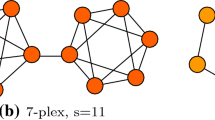Abstract
Graphs play a pivotal role in representing complex relationships across various domains, such as social networks and bioinformatics. Key to many applications is the identification of communities or clusters within these graphs, with k-edge connected components emerging as an important method for finding well-connected communities. Although there exist other techniques such as k-plexes, k-cores, and k-trusses, they are known to have some limitations.
This study delves into four existing algorithms designed for computing maximal k-edge connected subgraphs. We conduct a thorough study of these algorithms to understand the strengths and weaknesses of each algorithm in detail and propose algorithmic refinements to optimize their performance. We provide a careful implementation of each of these algorithms, using which we analyze and compare their performance on graphs of varying sizes. Our work is the first to provide such a direct experimental comparison of these four methods. Finally, we also address an incorrect claim made in the literature about one of these algorithms.
Access this chapter
Tax calculation will be finalised at checkout
Purchases are for personal use only
Similar content being viewed by others
Notes
- 1.
The full version of this paper is available here.
- 2.
References
Akiba, T., Iwata, Y., Yoshida, Y.: Linear-time enumeration of maximal k-edge-connected subgraphs in large networks by random contraction. In: CIKM, pp. 909–918 (2013)
Barabási, A.L., Oltvai, Z.N.: Network biology: understanding the cell’s functional organization. Nat. Rev. Genet. 5(2), 101–113 (2004)
Brin, S., Page, L.: Anatomy of a large-scale hypertextual web search engine. Comput. Netw. ISDN Syst. 30(1–7), 107–117 (1998)
Chang, L., Wang, Z.: A near-optimal approach to edge connectivity-based hierarchical graph decomposition. VLDB J. 15, 1–23 (2023)
Chang, L., Yu, J.X., Qin, L., Lin, X., Liu, C., Liang, W.: Efficiently computing k-edge connected components via graph decomposition. In: SIGMOD, pp. 205–216 (2013)
Chechik, S., Hansen, T.D., Italiano, G.F., Loitzenbauer, V., Parotsidis, N.: Faster algorithms for computing maximal 2-connected subgraphs in sparse directed graphs. In: SODA, pp. 1900–1918 (2017)
Delling, D., Sanders, P., Schultes, D., Wagner, D.: Engineering route planning algorithms. In: Lerner, J., Wagner, D., Zweig, K.A. (eds.) Algorithmics of Large and Complex Networks. LNCS, vol. 5515, pp. 117–139. Springer, Heidelberg (2009). https://doi.org/10.1007/978-3-642-02094-0_7
Esfahani, F., Daneshmand, M., Srinivasan, V., Thomo, A., Wu, K.: Scalable probabilistic truss decomposition using central limit theorem and h-index. Distrib. Parallel Databases 40(2–3), 299–333 (2022)
Esfahani, F., Srinivasan, V., Thomo, A., Wu, K.: Efficient computation of probabilistic core decomposition at web-scale. In: EDBT, pp. 325–336 (2019)
Fortunato, S.: Community detection in graphs. Phys. Rep. 486(3–5), 75–174 (2010)
Galil, Z., Italiano, G.F.: Reducing edge connectivity to vertex connectivity. ACM SIGACT News 22(1), 57–61 (1991)
Jeong, H., Mason, S.P., Barabási, A.L., Oltvai, Z.N.: Lethality and centrality in protein networks. Nature 411(6833), 41–42 (2001)
Karger, D.R.: Global min-cuts in RNC, and other ramifications of a simple min-cut algorithm. In: SODA, pp. 21–30 (1993)
Khaouid, W., Barsky, M., Venkatesh, S., Thomo, A.: K-core decomposition of large networks on a single PC. PVLDB 9(1), 13–23 (2015)
Leskovec, J., Chakrabarti, D., Kleinberg, J., Faloutsos, C., Ghahramani, Z.: Kronecker graphs: an approach to modeling networks. J. Mach. Learn. Res. 11, 985–1042 (2010)
Mislove, A., Marcon, M., Gummadi, K.P., Druschel, P., Bhattacharjee, B.: Measurement and analysis of online social networks. In: IMC 2007, pp. 29–42 (2007)
Nagamochi, H., Ibaraki, T.: A linear time algorithm for computing 3-edge-connected components in a multigraph. Jpn. J. Ind. Appl. Math. 9, 163–180 (1992)
Nagamochi, H., Watanabe, T.: Computing k-edge-connected components of a multigraph. IEICE Trans. Fundam. Electron. Commun. Comput. Sci. 76(4), 513–517 (1993)
Newman, M.: The structure and function of complex networks. SIAM Rev. 45(2), 167–256 (2003)
Page, L., Brin, S., Motwani, R., Winograd, T.: The PageRank citation ranking: bringing order to the web. In: Stanford InfoLab (1999)
Seidman, S.: Network structure and minimum degree. Soc. Netw. 5(3), 269–287 (1983)
Spirin, V., Mirny, L.A.: Protein complexes and functional modules in molecular networks. Proc. Natl. Acad. Sci. 100(21), 12123–12128 (2003)
Sun, H., et al.: Efficient k-edge connected component detection through an early merging and splitting strategy. Knowl. Based Syst. 111, 63–72 (2016)
Tsin, Y.H.: Yet another optimal algorithm for 3-edge-connectivity. J. Discr. Algorithms 7(1), 130–146 (2009)
Wang, J., Cheng, J.: Truss decomposition in massive networks. PVLDB 5(9), 812–823 (2012)
Wang, T., Zhang, Y., Chin, F.Y., Ting, H.F., Tsin, Y.H., Poon, S.H.: A simple algorithm for finding all k-edge-connected components. PLoS ONE 10(9), e0136264 (2015)
Wu, J., Goshulak, A., Srinivasan, V., Thomo, A.: K-truss decomposition of large networks on a single consumer-grade machine. In: ASONAM, pp. 873–880 (2018)
Yang, J., Leskovec, J.: Defining and evaluating network communities based on ground-truth. Knowl. Inf. Syst. 42(1), 181–213 (2015)
Zhou, R., Liu, C., Yu, J.X., Liang, W., Chen, B., Li, J.: Finding maximal k-edge-connected subgraphs from a large graph. In: Proceedings of the 15th International Conference on Extending Database Technology, pp. 480–491 (2012)
Author information
Authors and Affiliations
Corresponding author
Editor information
Editors and Affiliations
Rights and permissions
Copyright information
© 2024 The Author(s), under exclusive license to Springer Nature Switzerland AG
About this paper
Cite this paper
Sadri, H., Srinivasan, V., Thomo, A. (2024). Efficient Computation of K-Edge Connected Components: An Empirical Analysis. In: Dewar, M., et al. Modelling and Mining Networks. WAW 2024. Lecture Notes in Computer Science, vol 14671. Springer, Cham. https://doi.org/10.1007/978-3-031-59205-8_6
Download citation
DOI: https://doi.org/10.1007/978-3-031-59205-8_6
Published:
Publisher Name: Springer, Cham
Print ISBN: 978-3-031-59204-1
Online ISBN: 978-3-031-59205-8
eBook Packages: Computer ScienceComputer Science (R0)




